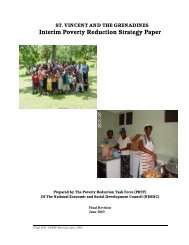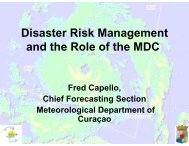The Anatomy of A Silent Crisis The Anatomy of A Silent Crisis
The Anatomy of A Silent Crisis The Anatomy of A Silent Crisis
The Anatomy of A Silent Crisis The Anatomy of A Silent Crisis
- TAGS
- anatomy
- www.bb.undp.org
Create successful ePaper yourself
Turn your PDF publications into a flip-book with our unique Google optimized e-Paper software.
A global challenge — Goals missed<br />
Climate adaptation also <strong>of</strong>fers significant benefits in promoting disaster preparedness. <strong>The</strong><br />
longer term development prospects <strong>of</strong> communities hit by natural disasters depend crucially on<br />
their capacity to cope with emergencies. This is both the case for disaster risk reduction and<br />
post disaster relief. An example <strong>of</strong> this would be supporting island states in the Caribbean to<br />
prepare for more severe and frequency hurricanes. <strong>The</strong>re is a range <strong>of</strong> interventions that can<br />
contribute to this, including early warning systems, evacuation plans, hurricane shelters and<br />
construction guidelines to “hurricane pro<strong>of</strong>” houses. Local knowledge can guide building <strong>of</strong><br />
relatively low cost, traditional wooden houses that are better able to withstand hurricanes, if<br />
built correctly. <strong>The</strong> Mainstreaming Adaptation to Climate Change programme in the Caribbean<br />
was initiated in 2002 to promote integration <strong>of</strong> adaptation and climate risk management<br />
strategies into water resource management, tourism, fisheries, agriculture and other areas. 36 <strong>The</strong><br />
programme is linked explicitly to the Millennium Development Goals and brings together a range<br />
<strong>of</strong> previously fragmented activities. 245<br />
<strong>The</strong> figure below illustrates how the climate change adaptation and mitigation agenda, disaster<br />
management, and national development policy all reinforce each other. As can be seen, there are<br />
both positive and negative influences from one to the other, evidence <strong>of</strong> the need to coordinate such<br />
measures.<br />
Figure 14 — Climate change agenda linked to disaster and development policies<br />
Source: Adapted from Schipper and Pelling 2006; GECHS: “Disaster Risk Reduction, Climate Change Adaptation and Human Security”, 2008<br />
75







